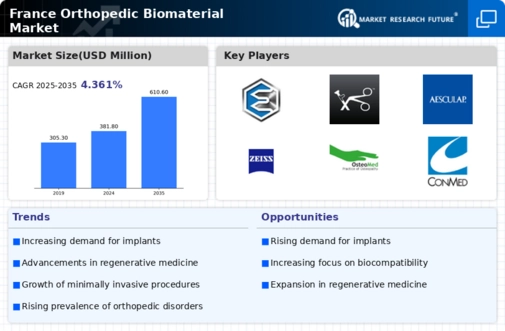Enhanced Regulatory Framework
The regulatory landscape for the orthopedic biomaterial market in France is evolving, with authorities implementing more stringent guidelines to ensure product safety and efficacy. This enhanced regulatory framework is likely to foster consumer confidence and encourage the adoption of new biomaterials. In 2025, compliance with these regulations is expected to drive market growth, as manufacturers invest in quality assurance and testing processes. The focus on regulatory compliance not only ensures patient safety but also promotes innovation, as companies strive to meet the high standards set by regulatory bodies. This dynamic is expected to positively impact the orthopedic biomaterial market.
Technological Integration in Healthcare
The integration of advanced technologies in healthcare is transforming the orthopedic biomaterial market in France. Innovations such as 3D printing and smart biomaterials are gaining traction, allowing for the customization of implants and devices tailored to individual patient needs. By 2025, it is anticipated that the adoption of these technologies will contribute to a market growth rate of around 12%. The ability to create patient-specific solutions enhances surgical outcomes and reduces the risk of complications. As healthcare providers increasingly embrace these technological advancements, the orthopedic biomaterial market is likely to witness substantial growth, driven by improved patient care and satisfaction.
Growing Prevalence of Orthopedic Disorders
The orthopedic biomaterial market is significantly influenced by the increasing prevalence of orthopedic disorders in France. Conditions such as osteoarthritis and fractures are becoming more common, particularly among the aging population. It is estimated that by 2025, the incidence of these disorders will rise by approximately 10%, leading to a higher demand for orthopedic interventions. This surge in cases necessitates the use of advanced biomaterials for implants and prosthetics, which are essential for effective treatment. Consequently, the orthopedic biomaterial market is poised for growth as healthcare providers seek innovative solutions to address these challenges.
Rising Demand for Minimally Invasive Procedures
The orthopedic biomaterial market in France is experiencing a notable increase in demand for minimally invasive surgical techniques. These procedures are preferred due to their reduced recovery times and lower risk of complications. As a result, the market for biomaterials that facilitate such surgeries is expanding. In 2025, the market is projected to grow by approximately 15%, driven by advancements in surgical techniques and materials. Surgeons are increasingly utilizing innovative biomaterials that enhance healing and integration with bone, thereby improving patient outcomes. This trend indicates a shift towards more patient-centric approaches in orthopedic care, which is likely to further propel the orthopedic biomaterial market.
Increased Investment in Research and Development
Investment in research and development (R&D) within the orthopedic biomaterial market is on the rise in France. Companies are allocating substantial resources to innovate and develop new biomaterials that offer enhanced performance and biocompatibility. In 2025, R&D spending is expected to account for around 20% of total market expenditure. This focus on innovation is crucial as it leads to the introduction of advanced materials, such as bioactive ceramics and polymers, which can significantly improve surgical outcomes. The ongoing collaboration between academic institutions and industry players is fostering a robust ecosystem for innovation, thereby driving growth in the orthopedic biomaterial market.























Leave a Comment